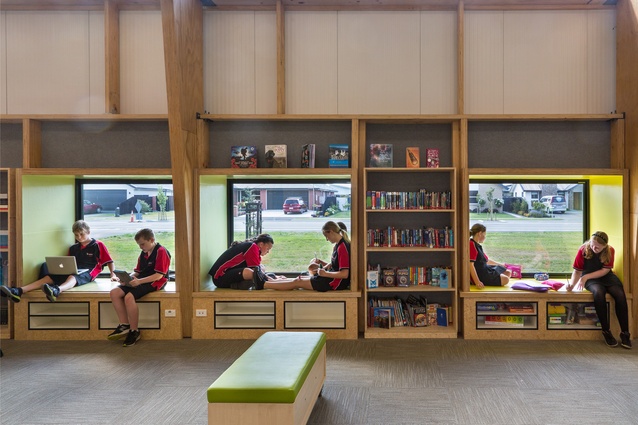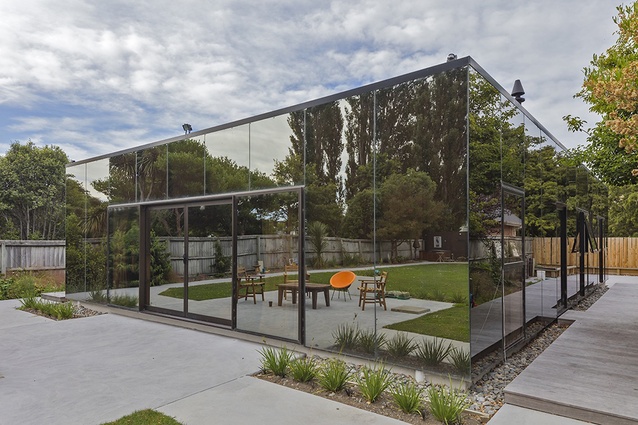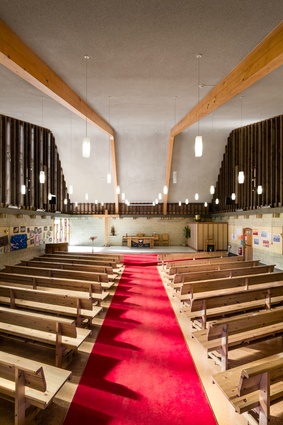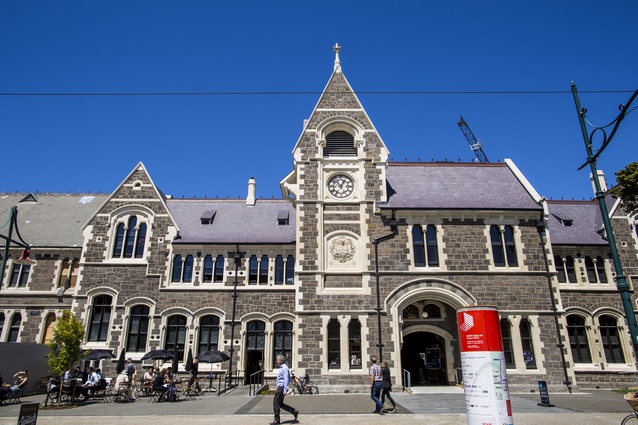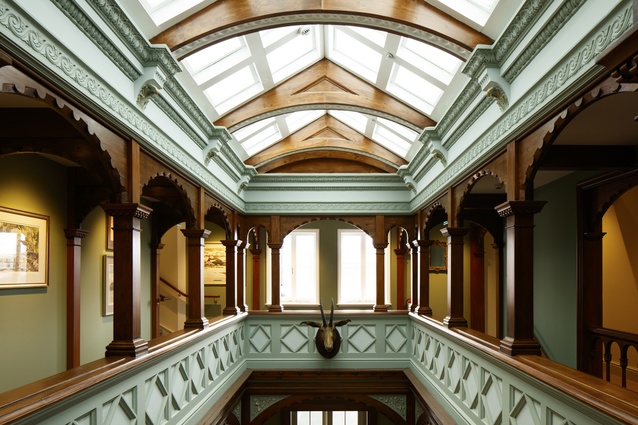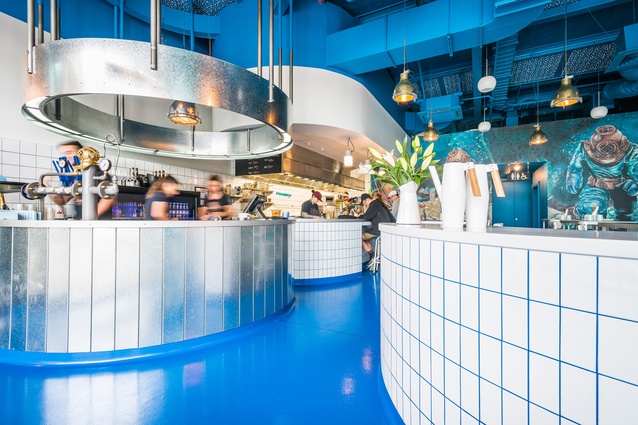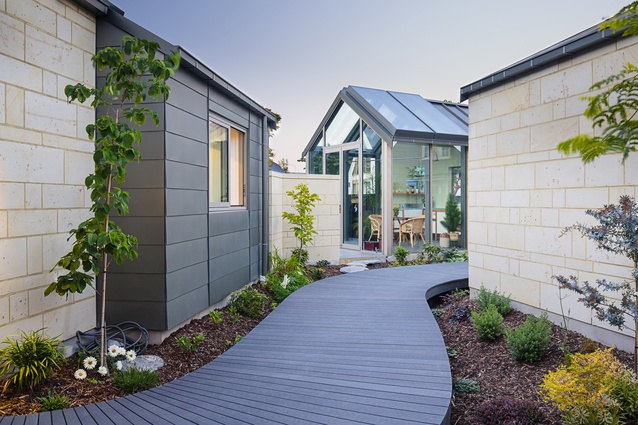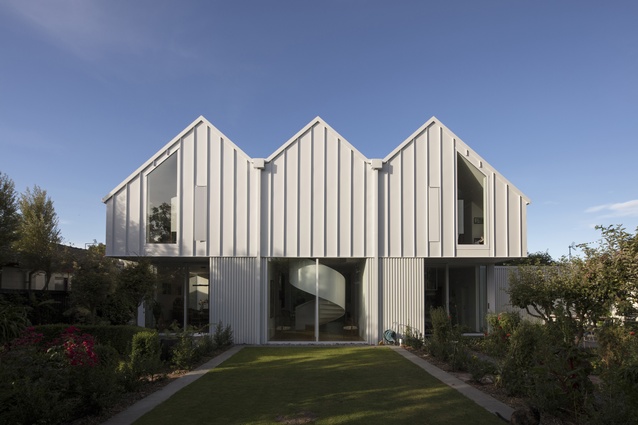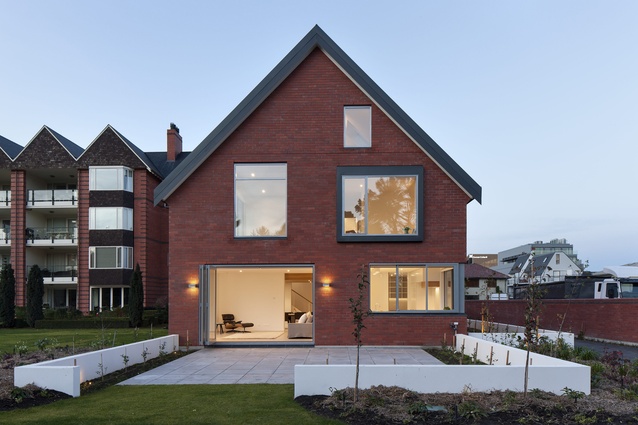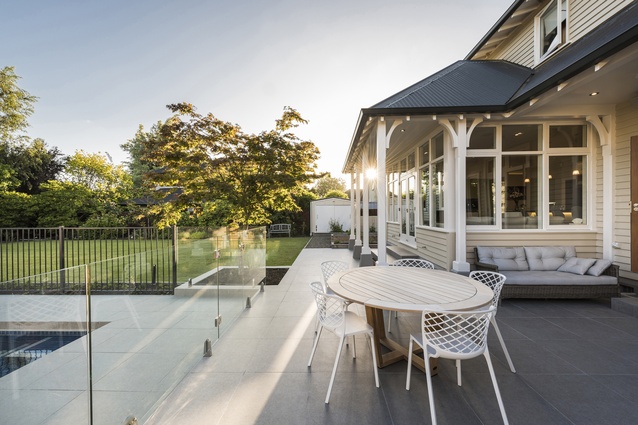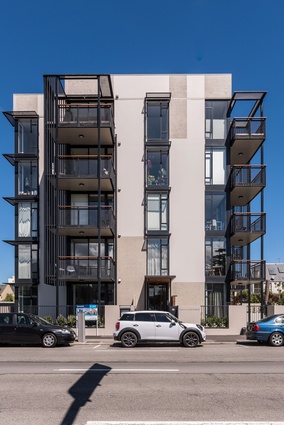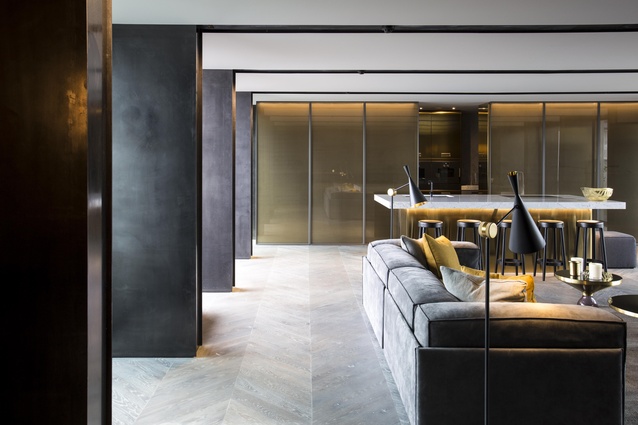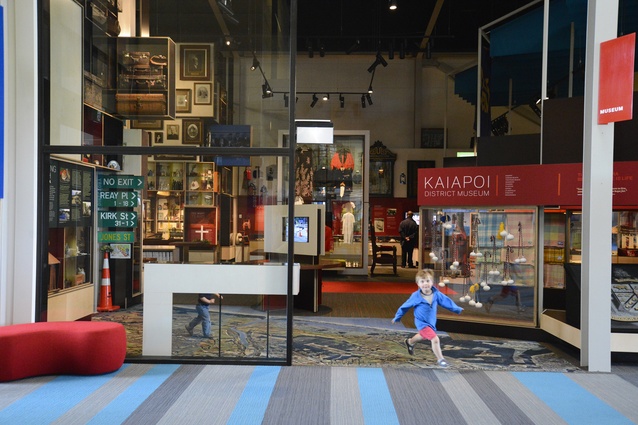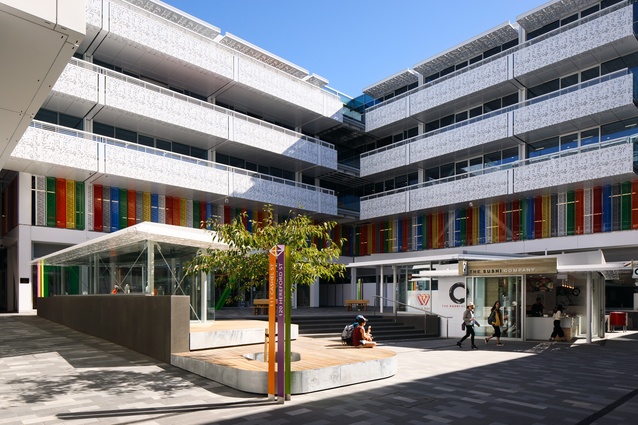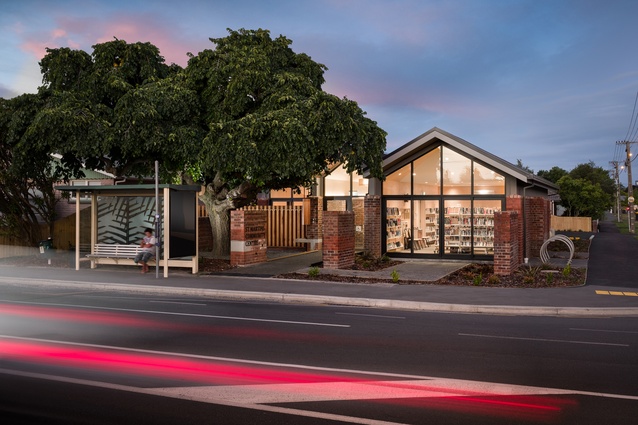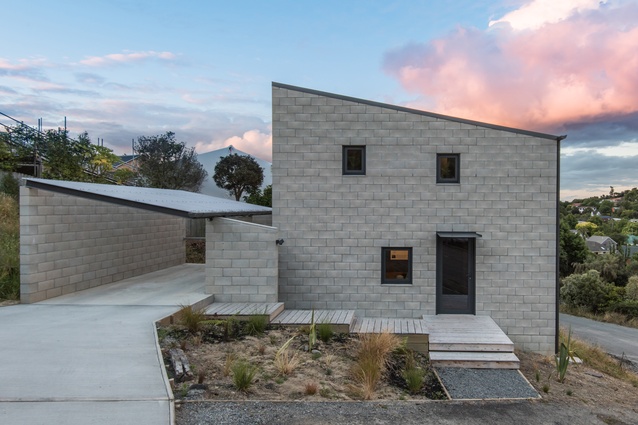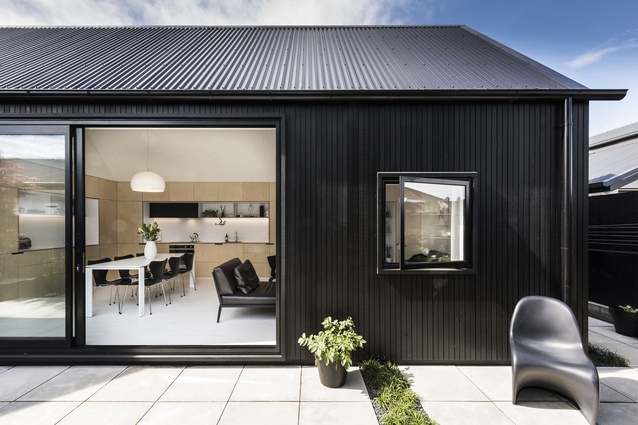Winners: 2017 Canterbury Architecture Awards
The 2017 Canterbury Architecture Awards were held at Christchurch’s Great Hall on Wednesday 24 May, with 25 projects, ranging from a glazed office building to a small fish and chip restaurant, being rewarded.
Mike Callaghan, the convenor of this year’s awards jury, said the projects illustrate the way the city is still changing “at an unprecedented pace” and that “the importance of architecture in our city is unquestionable.”
This year’s awards jury visited 40 shortlisted buildings. The jury was pleased to be able to award two new school buildings and two significant heritage reconstruction projects.
Full list of winners with citations:
COMMERCIAL ARCHITECTURE AWARDS:
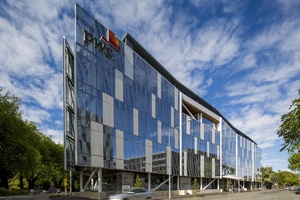
PwC Centre by Warren and Mahoney Architects
Replacing several office and apartment buildings along Cashel Street, the new PwC Centre sits proudly gesturing towards the Bridge of Remembrance, taking cues from the past in its reflective glazing and with the faceted north elevation cleverly reducing the scale of the building. The building entry, shared with a bustling café, is articulated by timber detailing, repeated again on the upper level terraces. A slim core to the south of the building allows for large uninterrupted floor plates to offer single or multiple tenancies. The architects have provided a considered and elegant solution to a key inner city site, celebrating the building’s form and function and giving a significant addition to the city’s growing West End neighbourhood.

Christchurch Adventure Park by AW Architects
Four simple building forms wrapped in black metal cladding and lined with pine plywood are placed within a forest of pines to create a Village Green atmosphere. Elements were prefabricated to help ease constraints of the project such as a tight time-frame and budget. Clear definition of architectural elements and a consistency of approach have resulted in a successful outcome for both client and architect.
EDUCATION AWARDS:

Medbury School New Teaching Block by Sheppard and Rout Architects
This two-storey, four-classroom teaching block, a key stage in the campus master plan, sets up a new rational architectural language within a sensitively observed context of greatly varied architectural stock. The new block creates flexible learning spaces for the school, based on current modern learning environment principles, with an emphasis on adaptability over time. A strong rhythm of vertical sun-screening fins on the east and west-facing façades give good solar shading, and also provide a more formal quality to reflect the verticality and scale of the site’s surrounding mature trees. A green wall on the north-facing elevation will continue to grow. Large sliding doors open from the shared learning space to a west courtyard which has been created as an outdoor learning space.

Marshland School by Stephenson and Turner NZ and Hayball
The relationship between the end-use client and architect was key to the success of this project. Ideas were thoroughly tested and refined before being implemented. The simple forms and structure of the school are brought to life through the clever use of a restrained and robust palette of materials. The use of an LVL portal structure is efficient but also provides warmth, rhythm and scale appropriate to the children using the spaces. Shelving and window seats, or ‘Dream Boxes’, occupy the spaces between the portals connecting the learning spaces to the external world. Strandboard-clad ‘mountains’ provide a robust and fun organising structure within the open internal learning environment, defining the separate but connected spaces crucial to the pedagogies practised by the school.
ENDURING ARCHITECTURE AWARDS:

18 Butler Street by Maurice Mahoney, Architect
Tucked away on a quiet suburban street in the heart of St Martins, this unique and surprisingly modest home offers joy and intrigues passers-by. Simply planned from a central axis, the original home designed by Maurice Mahoney in 1987 and built for his son (who later was married on the roof), was 9x9 metres and utilised the materiality and detailing the architect’s firm was then using on large commercial office buildings. An addition in 2010 in the same architectural language, and seamless earthquake repair work, have retained the unique nature of the home, sitting rear centre in the site reflecting the purposeful large front lawn and the surrounding trees in Hansens Park.

Templeton Chapel of the Holy Family by George Lucking, Architect
Unexpected in this rural location, this building by George Lucking, with its distinctive form, is a welcome surprise. The story of a fragile community once centred on this church and which now returns on Sundays to congregate here matches the building in its uniqueness. Entry is through a well-tended walled garden, with the entry and more functional spaces housed in a humble flat roofed form. An asymmetrical main roof rises smoothly towards the road and dramatically reaches its apex over the central pulpit before sharply descending again. The raw material palette of exposed concrete block and rough-sawn timber extends from the exterior throughout the space. A pair of glulam beams provide two refined timber arcs over the congregation. Bespoke timber furniture and Mondrian-esque stained glass windows speak of the 1960s. Alternating vertical timber elements and stained glass panels above the concrete block dado introduce warmth and rhythm, encouraging one to look skyward and changing the quality of light in the space. For a community at times without a place of belonging the importance of this place is palpable.
HERITAGE AWARDS:
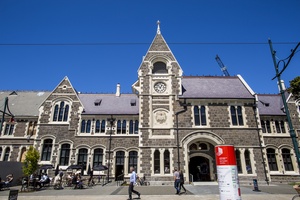
Christchurch Arts Centre Clock Tower & Great Hall by Warren and Mahoney Architects
Following the devastating earthquakes of 2010 and 2011, the extensive and complex task of restoration of the Christchurch Arts Centre began. The work on site has provided real challenges and complexities. Hands-on design development was required every day as no detail or space is the same. While replicating the existing fabric, the ‘matching’ materials were designed to code and based on their impact on the heritage fabric. The design approach agreed upon was that any new items were to be contemporary in nature, of a minimal palette, and were not to be confused with existing heritage. This important piece of New Zealand’s built history has been cared for and resurrected. These buildings are open for commercial and public use, but are sensitively placed in their heritage context. The result is spectacular and thought-provoking.
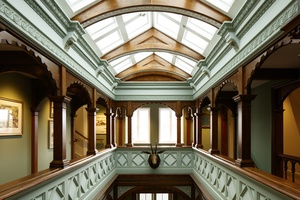
The Christchurch Club by Warren and Mahoney Architects
The project comprises reconstruction and restoration of the damaged and partially demolished Category 1 Clubhouse (1863) designed by Benjamin Mountfort, and its integration into a new Club facility. This was a complex project undertaken during a period of extreme uncertainty. The Mountfort restoration is dovetailed into a larger new-build composition in which the principal entertaining spaces are configured for optimal sun and shelter. The architect played a key role in championing the viability of the restoration, and through the masterplanning of the site, accommodating requirements for longevity, flexibility and desirability, while expressing the Club’s identity in anticipation of its next hundred years.
HOSPITALITY AND RETAIL AWARD:
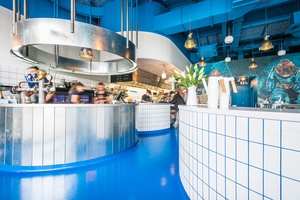
Fush by C Nott Architects
Fush presents Kiwi fish ‘n’ chips in a restaurant context. From the menu to the décor and the fitout to the marketing, the role of the architect is ever-present. The results speak for themselves: Fush is a busy restaurant serving a loyal clientele in a new part of Christchurch city. From the rounded service area clad in galvanised steel, to the open-plan kitchen, space has been designed and maximised to ensure a well-functioning business. Chairs, bathrooms, tables, sauce holders – everything has been designed for the business. This is an expert operator working with a clever architect. The extreme use of the colour blue derived from the architect’s intention to give the diner an underwater ambience. Among a group of chain store shops, Fush stands out as a one-off business, something for the community to call its own.
HOUSING AWARDS:
Montreal Street House by C Nott Architects

This central city house sits among historic cottages on a busy Christchurch street. The building is sympathetic in scale, silhouette and colour to the context of its neighbourhood. The apertures – both inside and out – are clever, fun, non-traditional, functional and aesthetically pleasing. Views within the house are revealed in unexpected places and views to the outside are maximised by the positioning of the house on itslong section. Planes are pushed, pulled and dragged into forms that are whimsical and engaging. This successful project shows an architect and client working in harmony and creating something unique: what a great house for three generations of a twenty-first century family looking to move on after the earthquake. This house manages to be both modern and traditional; after their visit, jury members left with smiles on their faces.
Resene Colour Award:
The two main gabled forms are painted a traditional red, linked by a declarative bright blue box – anything but traditional. Colours are employed on the simple forms both internally and externally to both stand out and sit back on a conservative city centre address, making the house a joyful addition to the streetscape.
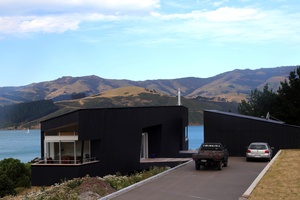
Sculptor’s House – OHAE Residence by Thom Craig Architects
Carefully sited on the contours of a spectacular promontory overlooking Akaroa Harbour, this home’s black fractured massing is broken into two forms framing the water views and setting up a dialogue with the heads beyond. The house, approached via a floating timber platform, is all on one level within its black weatherboard (boat-like) envelope, and is connected to the ground via a staircase that penetrates the ‘red belly’ of the main house, arriving below onto a sheltered deck overlooking Tikao Bay. The linear, nautical sense of spatial planning and movement though the house is terminated at either end with decks and extended roof planes framing horizontal views. A close collaboration over many years between the architect and the sculptor client is evident in this beautiful house.
Resene Colour Award:
The black weatherboard, boat-like envelope of the building emphasises the sculptural form of the house as object in the landscape. Use of the red on the undercroft is a reference to the Māori settlement of Tikao Bay on the site’s northern boundary, and the dazzle reinforces the nautical theme.

Kotare Street House by C Nott Architects
Upon arrival at Kotare Street one is greeted by the first glimpse of the garden and ‘gatehouse’. This small studio-cum-greenhouse forms the first in the collection of gabled forms, enticing visitors into the property. The main living space sits alongside the river, while the bedroom wing encloses the central courtyard, providing privacy. Once inside, the arrangement of forms allows occupants visual connections between the different spaces, out into the garden and river beyond. Open gables provide a sense of volume and roof windows allow light into the spaces and views out to neighbouring trees, while pergolas encourage the home to sink into the garden. House, garden and clients will grow together in this calming riverside masterpiece.
Resene Colour Award:
The material palette of Hinuera stone and aluminium cladding sits comfortably within the garden. The line between building and garden is blurred as the colours and materials seem to cross boundaries, naturally complementing each other.
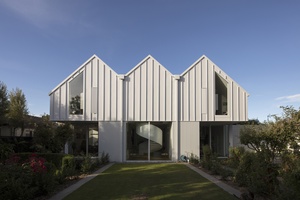
Fendalton Road House by Patterson Associates
Post-earthquake, this home balances remembrance and reinterpretation within the footprint of its 1910 predecessor. The white, triple-gabled house sits confidently within the existing garden at the centre of the property. Symmetrical in both planning and form, the house is entered through an exaggerated central hall. The double-height space houses a sculptural spiral stair and connects the two ground floor wings. Familiarity is established through planning: functions are rehoused with a careful re-ordering of spaces allowing improved connections to the existing garden. A new-found flexibility is provided through a series of pocket doors, curtains and retractable windows, allowing for more intimate proportions which reference the former house and open new possibilities. The success of this house lies in its honest references to what was and its bold acceptance of change.
Resene Colour Award:
The commitment to white is admirable and integral to the success of this project. The entirely white profile metal cladding reinforces the building’s sculptural form, accentuating it against the greens of the established garden. Once inside the house, the depth of white is further explored through different materials and textures. The white colour takes a more recessive role when forming a gallery to showcase the client’s art collection and antique furniture.
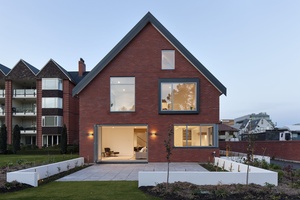
Parkbridge House by Four Walls Architecture
Replacing the historic McKellar House, with the forms of the main apartment building looming behind, this truly sympathetic addition to the Parkbridge apartment complex is a single-family home enjoying extensive shared landscaping and unobstructed views to Hagley Park. Working within restrictive design, material and body corporate processes, the architect’s solution is a considered and contemporary response comfortably standing on its own while remaining in keeping with the existing architectural language. Internal spaces are connected via a central atrium across the three levels, with constant surprises of natural light and view shafts. Experiencing the calming interior spaces, you can easily forget you are on the edge of the central city within a large apartment community and alongside a busy intersection.
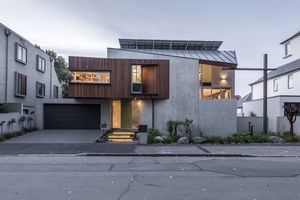
Cambridge Home by Cymon Allfrey Architects
This house in the central city presents a strong sculptural form to the street and combines the client’s love of concrete with the warmth of timber cladding. At the rear, the house opens to a beautiful secluded garden. The smaller interior spaces, with their carefully considered openings to maintain privacy, are pleasant alternatives to the usual large open-plan spaces. A secret play space for the grandchildren and a serene family bathroom with steeply sloping ceiling and beautiful diffuse light are highlights. A ground-source heat recovery system and solar panels ensure that the long-term costs of running the house will be kept to a minimum. Rather than being hidden away, the solar panels are celebrated and contribute to the success of the street façade.
HOUSING – ALTERATIONS AND ADDITIONS AWARD:
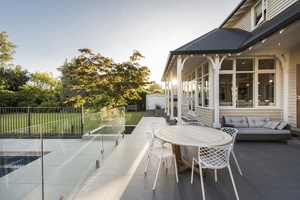
Knowles House by Dalman Architecture
Requiring extensive earthquake repairs to their family home, the clients took the opportunity to remove the vehicle dominance to the rear of their site and insert a swimming pool and pool house. Other improvements included the sensitive relocation of the garage within the fabric of the existing character home, north terrace louvres and wind shelter, as well as extensive terracing and landscape improvements. The traditional role of the architect and the architect’s expertise were celebrated in this project – the architect managed the complete repair and refurbishment works under three separate contracts between the client and insurance company. The process has resulted in sympathetic alterations and hidden repair works to the clients’ ‘forever’ family home.
HOUSING – MULTI-UNIT AWARD:
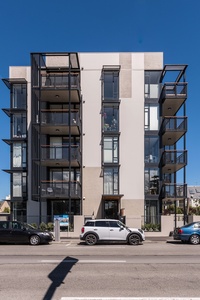
Rakaia Apartments by Wilson and Hill Architects
The first stage of this inner-city apartment development is a simple, robust and efficient five-level building housing one and two-bedroom apartments. Cleverly planned to allow for the purchase and combination of two adjoining apartments, the internal detailing and fit-out is simple and unassuming, enabling apartment owners’ personalities to take precedence. Each apartment benefits from generous balconies articulating the building form and arranged to offer maximum sunlight, privacy from its neighbour and views towards Cranmer Square. The raw materiality of textured and painted precast concrete, steel and aluminium detailing is softened by the ground floor apartments’ large landscaped courtyards. The architects and client have achieved an efficient solution for affordable inner-city apartment living in Christchurch.
INTERIOR ARCHITECTURE AWARDS:
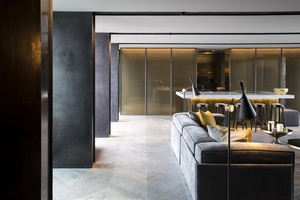
Diver Apartment by MAP (2016)
The dark and brooding interior of this luxurious inner-city bachelor pad is refined and sophisticated. A rich palette of materials, including polished brass and blackened steel, is beautifully detailed and constructed. Services such as lighting and air conditioning are carefully considered and integrated. The living space opens out onto a private terrace complete with a swimming pool that also acts as a water feature to drown out the noise of the traffic below. This is an oasis of calm in downtown Christchurch.
Kaiapoi Museum by Pearson & Associates Architects
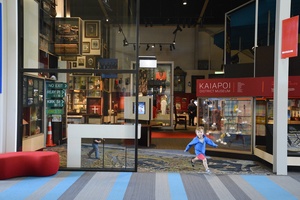
This is a thoughtful and respectful response to an eclectic community collection that celebrates and documents the history of Kaiapoi. Central to the scheme is the volunteers – the life blood of the museum – being on display and working on the artefacts within the main space, surrounded by a series of ‘trade pavilions’ displaying Kaiapoi’s rich exporting and manufacturing. The exhibition cleverly makes use of all of the available space by stacking and layering the artefacts within carefully detailed display cabinetry, allowing the visitor to focus on the individual items at an intimate and domestic scale.
Resene Colour Award:
The use of strong colour in this exhibition lends coherence to the diverse collection of objects on display. Coloured perspex within the well-detailed display cabinetry enhances the objects and the viewer’s experience of them.
PLANNING AND URBAN DESIGN AWARD:
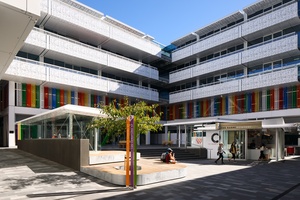
BNZ Centre by Sheppard and Rout Architects
The exemplary planning and urban design attributes of the BNZ Centre prove the dedication and perseverance of the architect’s role in inner-city developments. Bridging Cashel and Hereford Streets, the unapologetically large retail and office development covers half a city block. It is dissected by multiple laneways and arcades connecting to the surrounding streets and neighbouring developments, all coming together to meet at a generously scaled internal public courtyard. The prioritised public realm enjoys active edges hosting a range of retail and hospitality tenants; building entry points are secondary and car parking completely removed from ground level. Scale, texture and materiality are explored across the building’s fabric to provide visual interest to the distinctly different north and south blocks.
PUBLIC ARCHITECTURE AWARDS:

St Martin’s Community Centre Christchurch by Plus Architecture (Christchurch)
The domestic scale, combined with the richness and texture of the material palette, makes this building a valuable addition to the community. It is formulated as a simple spine with two community spaces on either side, a library and a hall. Interest and volume is created through the addition of three gabled forms. Old bricks were collected and laid in various patterns to create a series of walls that run through the building, linking interior spaces with private courtyard spaces. Security and privacy is cleverly managed by a palisade of cantilevered timber around the exterior spaces that still allows a visual connection with the street. The community hall is a successful and adaptable space that is well used by the community. The warmth of plywood lining, the folded ceiling plane and natural light make this a lovely space to inhabit.
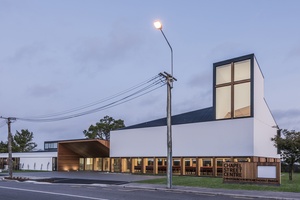
Christchurch North Methodist Church by Dalman Architecture
In response to the constrained budget for rebuild following the demolition of the existing church, the architect has adopted a minimalist approach to the church design, both inside and out. This has resulted in a strong simple form that speaks of its religious function. In a deliberate step away from the traditional closed church building, the design welcomes passers-by to view the congregation and worship space through 2-metre high windows to Chapel Street. The timber paneled ceiling in the worship space joyfully ascends to the spire in the corner of the building. Natural light pours from the high level spire window, which acknowledges the spire of the former church which was a local landmark.
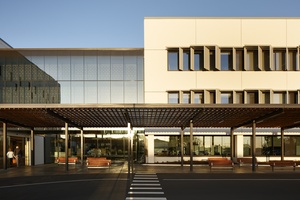
Burwood Hospital by Jasmax, Klein and Sheppard and Rout in association
Three practices have combined their expertise and knowledge of the site into one collaborative team. Every aspect of the new Burwood Hospital is focused on the staff and on patients’ wellbeing, often through long rehabilitation stays. The sympathetically-scaled ward buildings – with their nod to Canterbury’s architectural heritage – run off a central circulation spine, aligning circulation to other hospital buildings. Public spaces are deployed central to the large building with internal courtyards, materiality and colour, while all ward rooms have views to landscaped parkland. Intermediate resting and family spaces along each ward provide for comfortable patient stays. Extensive use of natural ventilation allows patients personal control of their space, and together with extensive natural lighting contribute to the homely environment the architects have explored throughout this much-celebrated and significant new facility.
SMALL PROJECT ARCHITECTURE AWARDS:
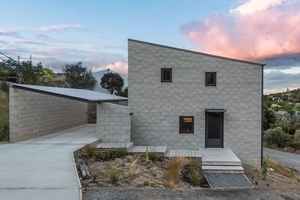
h01 house by Maguire and Harford Architects
The architect has inventively approached a small site and limited budget to create a house that is both highly energy efficient and elegantly restrained. The form is sculptural, with irregularly placed windows enlivening the stark block façades while at the same time optimising sunlight and reducing heat-loss. Internally, both levels of the plan focus around a double-height living space with tall windows. Deep reveals to openings frame views of the valley and hills, and the city in the distance. Darkened walls create a sense of calmness and retreat.
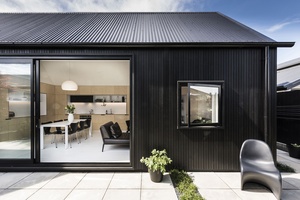
Urban Cottage by Colab Architecture
Hidden on a rear site, the 80m2 ‘Urban Cottage’ is an exemplar of succinct inner city living – a considered deconstruction of an early colonial worker’s cottage, adapted and re-arranged into two gabled forms to suit contemporary conditions. This project sees the public spaces separated from the private by the central entry hall. This corridor acts as both the physical break and a clever opportunity to integrate storage and back-of-house functions discretely within bespoke joinery. The purposeful arrangement of the buildings on the site enables a private courtyard, a series of small gardens and room enough for a covered carport. The dark weatherboard exterior serves as a bold statement; inside, a softer colour palette and timber accents are complemented by clean lines. Despite the modest floor area, a steep gabled ceiling in the living wing, generous stud-height and well-proportioned openings to the courtyard create a generous sense of space.
All winners of the 2017 Canterbury Architecture Awards are eligible for shortlisting in the New Zealand Architecture Awards, which will be decided later in the year, and announced in November.




